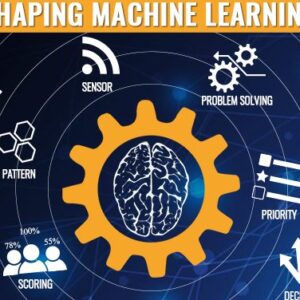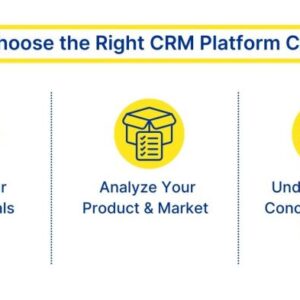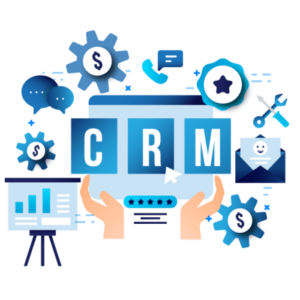The Role of CRM in Digital Transformation for Enterprises isn’t just about better customer service; it’s a complete overhaul. Think of it as upgrading your business from a clunky rotary phone to a sleek, hyper-connected smartphone. We’re talking seamless data flow, personalized marketing blasts that actually hit the mark, and operational efficiency that’ll make your competitors weep. This isn’t just about tech; it’s a cultural shift, a strategic rethink of how you connect with your customers and manage your entire business. Get ready to dive into the CRM revolution.
This deep dive will explore how a robust CRM system isn’t just a tool, but a core component of successful digital transformation. We’ll cover everything from integrating CRM with your existing systems to leveraging data analytics for sharper insights and ultimately, a more agile and profitable enterprise. We’ll also address the security and ethical considerations crucial for handling sensitive customer data in today’s digital landscape. Ready to unlock the power of CRM? Let’s go.
Defining Digital Transformation in the Enterprise Context
Digital transformation isn’t just about adopting new technologies; it’s a fundamental reshaping of how an enterprise operates, interacts with customers, and competes in the market. It’s a multifaceted process involving technological advancements, streamlined operations, and a significant cultural shift within the organization. Think of it as a complete overhaul, not just a quick fix.
Digital transformation encompasses a wide range of changes across an enterprise. Technological upgrades are a crucial component, including the implementation of new software, hardware, and cloud-based systems. However, equally important are operational changes, such as optimizing workflows, automating processes, and improving data analytics capabilities. Finally, a successful transformation necessitates a cultural shift, encouraging employees to embrace innovation, collaboration, and data-driven decision-making. Without this cultural buy-in, even the most advanced technology will struggle to deliver its full potential.
Key Drivers of Enterprise Digital Transformation
Several factors are compelling enterprises to embark on digital transformation journeys. The increasing reliance on digital channels by customers demands a responsive and agile approach from businesses. Competition from digitally native companies and the need to improve efficiency and reduce costs are also significant drivers. Furthermore, the sheer volume of data generated today necessitates the adoption of advanced analytics tools and techniques to gain valuable insights and make better business decisions. The pressure to innovate and stay ahead of the curve in a rapidly evolving technological landscape is another powerful motivator.
Examples of Successful and Unsuccessful Digital Transformations
Let’s examine some real-world examples. Consider Netflix’s transition from a DVD rental service to a global streaming giant. This successful transformation involved a massive technological shift to a cloud-based infrastructure, a sophisticated recommendation engine powered by data analytics, and a significant cultural change embracing data-driven decision-making. Their CRM system played a vital role in understanding customer viewing habits, personalizing recommendations, and improving customer retention. In contrast, consider a hypothetical retail company that invested heavily in a new e-commerce platform without adequately training its employees or adapting its customer service strategy. The result? A technologically advanced platform struggling to meet customer expectations, leading to low conversion rates and ultimately, failure. The CRM system, in this case, remained underutilized, failing to leverage the customer data generated by the new platform. This highlights the importance of a holistic approach, encompassing technological upgrades, operational efficiency, and cultural alignment. A CRM system, therefore, is not a magic bullet, but a powerful tool that needs to be integrated strategically into the broader transformation strategy.
CRM’s Role in Enhancing Customer Relationship Management

Source: slideteam.net
In today’s hyper-competitive digital landscape, understanding and nurturing customer relationships is paramount for enterprise success. A robust CRM system isn’t just a database; it’s the engine driving personalized experiences and efficient operations, ultimately boosting customer loyalty and profitability. It’s the bridge connecting data, interaction, and service, transforming raw information into actionable insights.
CRM systems significantly improve how businesses manage customer interactions, moving beyond simple contact lists to sophisticated, data-driven strategies. This enhanced management translates directly into improved customer satisfaction, increased sales, and a stronger brand reputation.
Improved Customer Data Collection, Analysis, and Utilization
Effective CRM systems go beyond basic contact information. They gather a wealth of data from various touchpoints – website interactions, social media engagement, purchase history, customer service interactions, and more. This data is then analyzed using sophisticated algorithms to identify trends, predict customer behavior, and segment audiences for targeted campaigns. For example, a clothing retailer might use CRM data to identify customers who frequently purchase specific styles and then proactively offer them discounts on similar items or new releases. This data-driven approach allows for a much more personalized and effective marketing strategy than traditional methods. The key is not just collecting data, but intelligently leveraging it to understand customer needs and preferences.
Personalized Customer Interactions and Targeted Marketing Campaigns
With a comprehensive understanding of customer preferences, CRM systems facilitate highly personalized interactions. This goes beyond simple email personalization (though that’s a good starting point). Imagine a travel agency using CRM data to recommend tailored vacation packages based on a customer’s past travel history, preferred destinations, and budget. Or a bank offering personalized financial advice based on individual financial goals and risk tolerance. These targeted campaigns are far more effective than generic marketing blasts, leading to higher conversion rates and stronger customer relationships. The personalization isn’t just about names; it’s about providing relevant and timely offers that resonate with individual customer needs.
Streamlined Customer Service Processes and Enhanced Customer Satisfaction
CRM systems revolutionize customer service by centralizing all customer interactions in one place. This means customer service representatives have instant access to a complete history of each customer’s interactions, allowing them to provide faster, more personalized, and more effective support. Features like automated chatbots and self-service portals further streamline processes, reducing wait times and improving overall customer satisfaction. For instance, a telecom company can use its CRM to quickly resolve technical issues by accessing past troubleshooting steps and account details, leading to quicker resolution times and happier customers. This efficiency not only improves customer experience but also frees up customer service representatives to focus on more complex issues.
Comparison of Traditional and Modern CRM Approaches
| Approach | Data Management | Customer Interaction | Service Efficiency |
|---|---|---|---|
| Traditional CRM | Limited data points, often siloed; manual data entry; limited analytics | Generic marketing campaigns; limited personalization; reactive customer service | Manual processes; longer resolution times; higher operational costs |
| Modern, Digitally-Driven CRM | Comprehensive data collection from multiple sources; automated data entry; advanced analytics and AI | Personalized marketing campaigns; proactive customer engagement; omnichannel communication | Automated workflows; faster resolution times; reduced operational costs; improved customer satisfaction |
Integrating CRM into Enterprise-Wide Digital Strategies
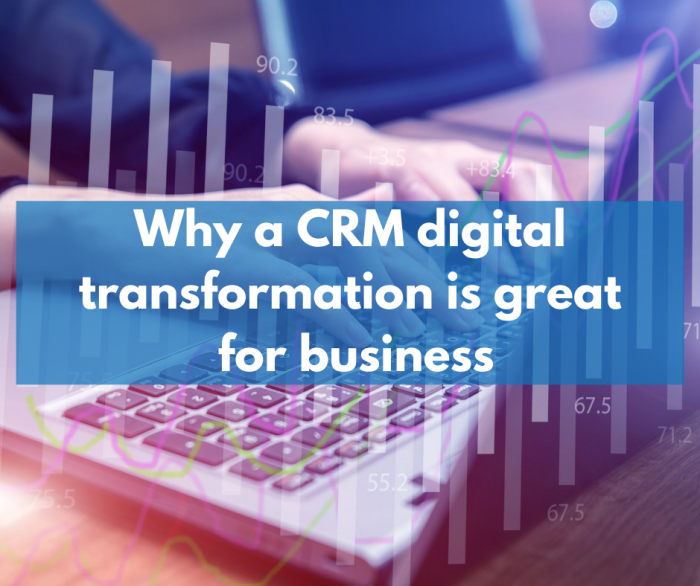
Source: co.uk
Digital transformation hinges on leveraging customer data effectively, and CRM is the cornerstone. To truly unlock its potential, however, enterprises need to seamlessly integrate their CRM with marketing automation, as explored in this insightful article: Integrating CRM with Marketing Automation: Unlocking the Power of Data. This integration fuels personalized campaigns and smarter business decisions, ultimately boosting the ROI of your digital transformation journey.
So, you’ve got your shiny new CRM system and a digital transformation strategy humming along. But the real magic happens when these two powerhouses connect. Integrating your CRM isn’t just about plugging it in; it’s about creating a seamless, data-rich ecosystem that fuels your entire business. This section explores the key integration points, benefits, challenges, and a roadmap for success.
Integrating your CRM system effectively across your enterprise unlocks a wealth of opportunities. A holistic approach ensures that your CRM becomes the central nervous system, connecting various departments and systems for a unified customer view. This integrated approach drives efficiency, improves customer experiences, and ultimately boosts the bottom line.
Key Integration Points Between CRM and Other Enterprise Systems
Successful CRM integration hinges on connecting it with other core enterprise systems. This involves establishing a smooth data flow between your CRM and platforms like Enterprise Resource Planning (ERP) systems, marketing automation tools, and customer support systems. For example, integrating with an ERP system allows for real-time updates on inventory levels, order status, and shipping information, providing your sales team with complete visibility into the customer journey. Linking with marketing automation tools enables targeted campaigns based on CRM data, improving lead nurturing and conversion rates.
Benefits of Seamless Data Flow Between CRM and Other Systems, The Role of CRM in Digital Transformation for Enterprises
The advantages of a well-integrated CRM are numerous. Seamless data flow translates to a single source of truth for customer information, eliminating data silos and inconsistencies. This unified view enables personalized customer experiences, better sales forecasting, and more efficient operational processes. Imagine a scenario where a customer service agent can instantly access a customer’s complete purchase history, past interactions, and ongoing support requests – all from a single screen. This level of information empowers agents to provide faster, more effective support, boosting customer satisfaction and loyalty. The improved data visibility also allows for more accurate sales forecasting, leading to better resource allocation and improved business planning.
Challenges Associated with Integrating CRM into Existing Enterprise IT Infrastructure
While the benefits are clear, integrating CRM into existing IT infrastructure presents several challenges. Legacy systems, incompatible data formats, and data security concerns are common hurdles. The complexity of the integration process itself can also be significant, requiring specialized technical expertise and potentially lengthy implementation timelines. For instance, migrating data from disparate systems to a unified CRM platform can be a complex undertaking, requiring data cleansing, transformation, and validation. Furthermore, ensuring data security and compliance with relevant regulations during the integration process is paramount. Companies often underestimate the time and resources required for a smooth integration, leading to delays and cost overruns.
A Step-by-Step Process for Successful CRM Integration Within a Digital Transformation Project
A phased approach is crucial for successful CRM integration. First, define clear objectives and key performance indicators (KPIs) to measure success. Next, conduct a thorough assessment of your existing IT infrastructure and identify potential integration points. Then, select the appropriate integration methods (e.g., APIs, ETL tools) and develop a detailed integration plan. The next step involves data migration and cleansing, followed by rigorous testing and validation. Finally, ongoing monitoring and optimization are essential to ensure the system remains efficient and effective. Think of it like building a house – you wouldn’t start constructing the roof before laying the foundation. A structured, phased approach ensures a solid, scalable, and ultimately successful integration.
CRM’s Contribution to Operational Efficiency and Agility: The Role Of CRM In Digital Transformation For Enterprises
In today’s fast-paced business environment, operational efficiency and agility are no longer luxuries but necessities for survival. A robust CRM system acts as a powerful engine, driving these crucial aspects of enterprise success. By automating tasks, streamlining workflows, and providing real-time insights, CRM empowers businesses to respond quickly to market changes and customer demands, ultimately boosting profitability and competitive edge.
CRM systems significantly enhance operational efficiency through automation and streamlined workflows. Imagine a scenario where sales reps spend hours manually entering data, chasing down information, and following up on leads. A CRM system automates these repetitive tasks, freeing up valuable time for more strategic activities like building relationships and closing deals. Workflow automation features, such as automated email sequences and lead assignment rules, ensure that no opportunity slips through the cracks and that customer interactions are consistent and efficient. This translates directly into increased productivity and reduced operational costs.
Improved Decision-Making and Business Agility
Real-time data and analytics provided by a CRM system are game-changers for decision-making. Instead of relying on outdated reports and gut feelings, businesses can leverage the comprehensive data within their CRM to gain a clear understanding of customer behavior, sales trends, and marketing campaign performance. This allows for quicker identification of problems and opportunities, enabling faster and more informed responses to market changes and customer needs. For example, a sudden drop in sales within a specific customer segment can be immediately detected and investigated, allowing for prompt corrective actions, such as targeted marketing campaigns or improved customer service strategies. This data-driven approach leads to increased business agility and a significant competitive advantage.
Impact on Sales, Customer Service, and Marketing
The impact of CRM extends across all key business functions. In sales, CRM streamlines the sales process from lead generation to closing deals, improving sales team productivity and increasing conversion rates. Customer service benefits from improved case management, faster resolution times, and enhanced customer satisfaction. Marketing teams gain access to valuable customer insights, enabling the creation of more targeted and effective campaigns. For instance, a CRM system can identify high-value customers and allow for personalized marketing messages, improving customer engagement and loyalty. The integrated nature of CRM ensures that all departments work with a unified view of the customer, leading to a more cohesive and effective customer experience.
Key Performance Indicators (KPIs) for Measuring Digital Transformation Success
Tracking the right KPIs is essential to measure the success of your digital transformation initiatives. A CRM system provides a wealth of data that can be used to monitor key performance indicators across various aspects of your business.
The following KPIs can be tracked using CRM data to demonstrate the impact of digital transformation:
- Customer Acquisition Cost (CAC): Measures the cost of acquiring a new customer.
- Customer Lifetime Value (CLTV): Predicts the total revenue generated by a customer throughout their relationship with the company.
- Customer Churn Rate: Indicates the percentage of customers who stop doing business with the company within a specific period.
- Sales Cycle Length: Measures the time it takes to close a deal.
- Average Revenue Per User (ARPU): Calculates the average revenue generated per customer.
- First Response Time (FRT): Measures the speed of initial response to customer inquiries.
- Customer Satisfaction (CSAT): Gauges customer satisfaction levels.
- Net Promoter Score (NPS): Measures customer loyalty and willingness to recommend the company.
CRM and Data Analytics for Improved Business Insights
Unlocking the true power of your CRM isn’t just about managing contacts; it’s about transforming raw data into actionable intelligence. Modern CRM systems, coupled with robust analytics, offer a powerful engine for driving strategic decision-making and boosting your bottom line. By leveraging the wealth of information captured within your CRM, you can gain a deep understanding of your customers, optimize your operations, and ultimately, achieve sustainable growth.
CRM systems facilitate data-driven decision-making through a variety of advanced analytics capabilities. These systems go beyond simple reporting, offering tools for complex data analysis, including segmentation, trend identification, and predictive modeling. This allows businesses to move away from gut feelings and embrace a more scientific approach to understanding customer behavior and market trends. The result? More effective marketing campaigns, improved customer service, and better product development.
Predictive Analytics for Anticipating Customer Needs
Predictive analytics uses historical data and machine learning algorithms to forecast future outcomes. In the context of CRM, this means anticipating customer needs and behaviors. For example, a telecom company might use predictive analytics to identify customers at high risk of churning. By analyzing usage patterns, billing history, and customer service interactions, the system can flag these at-risk customers, allowing the company to proactively offer retention incentives and prevent churn. Another example could be a retailer predicting which products a customer is likely to purchase based on their past browsing and purchasing history, allowing for personalized recommendations and targeted marketing efforts. This proactive approach allows businesses to personalize their interactions, improving customer satisfaction and loyalty.
Utilizing CRM Data to Enhance Products and Services
The data stored within a CRM system is a goldmine of information about customer preferences, pain points, and feedback. This data can be used to improve existing products and services and to inform the development of new ones. For instance, a software company might analyze customer support tickets to identify recurring issues and bugs in their software. This feedback directly informs product development, leading to improved software quality and increased customer satisfaction. Similarly, a clothing retailer might analyze customer purchase history and feedback to identify popular styles, colors, and sizes, informing their inventory management and future product lines.
Data Flow and Business Intelligence
Imagine a visual representation: Data streams in from various sources – website analytics, marketing automation platforms, sales data, customer service interactions, and social media monitoring. This diverse data converges into a central CRM system. The CRM system then processes and cleans this data, organizing it into a usable format. Advanced analytics tools within the CRM then analyze this consolidated data, generating reports, dashboards, and visualizations that provide valuable business insights. These insights are then used to inform strategic decisions across various departments, such as marketing, sales, and customer service, leading to improved efficiency and profitability. This closed-loop system ensures that data is not only collected but actively used to improve business performance.
Security and Ethical Considerations in CRM Implementation
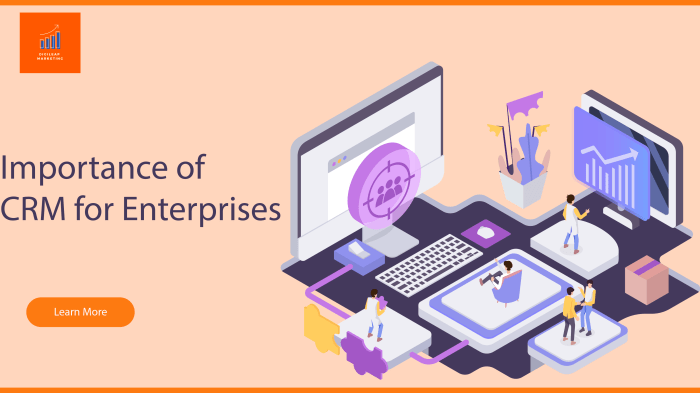
Source: digileapservices.com
Implementing a CRM system as part of a digital transformation isn’t just about streamlining sales; it’s about safeguarding sensitive customer data. The vast amounts of personal information stored within a CRM system make it a prime target for cyberattacks, and mishandling this data can lead to significant legal and reputational damage. Therefore, security and ethical considerations must be front and center throughout the entire process, from initial planning to ongoing maintenance.
Potential Security Risks Associated with CRM Systems
CRM systems, by their very nature, house a treasure trove of sensitive customer information: names, addresses, contact details, purchase history, financial information, and potentially even more sensitive data depending on the industry. This makes them attractive targets for malicious actors. Potential security risks include data breaches through hacking, phishing attacks targeting employees, insider threats from disgruntled employees, and vulnerabilities within the CRM software itself or its integrations with other systems. Unsecured access points, weak passwords, and lack of regular security updates all significantly increase the risk of a data breach. The consequences of such a breach can range from financial penalties and legal action to irreparable damage to brand reputation and customer trust.
Data Privacy and Compliance with Regulations
The importance of data privacy cannot be overstated. Regulations like the General Data Protection Regulation (GDPR) in Europe and the California Consumer Privacy Act (CCPA) in the US mandate specific requirements for handling personal data. These regulations grant individuals rights regarding their data, including the right to access, rectify, and erase their information. Non-compliance can result in hefty fines and legal repercussions. Businesses must ensure their CRM systems are configured to comply with all relevant data privacy regulations, including implementing appropriate data retention policies and providing users with clear and transparent information about how their data is being collected, used, and protected.
Best Practices for Ensuring Data Security and Ethical Data Handling
Implementing robust security measures is paramount. This includes employing strong password policies, multi-factor authentication, regular security audits, and encryption of data both in transit and at rest. Employee training on security awareness is crucial to mitigate the risk of phishing attacks and insider threats. Regular software updates and patches are essential to address vulnerabilities. Furthermore, ethical data handling involves establishing clear data governance policies, ensuring data minimization (collecting only necessary data), and obtaining explicit consent for data processing whenever required. Transparency and accountability are key to building and maintaining customer trust.
Checklist of Security Measures for CRM Deployment
Before deploying a CRM system, a thorough security assessment is vital. A comprehensive checklist should include:
- Conduct a thorough risk assessment to identify potential vulnerabilities.
- Implement strong password policies and multi-factor authentication.
- Encrypt all sensitive data both in transit and at rest.
- Regularly update and patch the CRM software and its integrations.
- Establish a robust data backup and recovery plan.
- Implement access control measures to restrict access to sensitive data based on roles and responsibilities.
- Conduct regular security audits and penetration testing.
- Develop and implement an incident response plan to handle data breaches.
- Provide comprehensive employee training on data security and ethical data handling.
- Ensure compliance with all relevant data privacy regulations.
Following this checklist will significantly reduce the risk of security breaches and help organizations maintain ethical data handling practices. The investment in security is not just a cost; it’s an investment in protecting the business, its customers, and its reputation.
Final Conclusion
So, there you have it – the undeniable power of CRM in driving enterprise digital transformation. It’s not just about adopting new technology; it’s about fundamentally changing how you operate, how you understand your customers, and how you achieve business goals. By strategically integrating CRM, embracing data-driven decision-making, and prioritizing data security, businesses can unlock unprecedented levels of efficiency, agility, and customer satisfaction. The future is digital, and CRM is your key to unlocking it.

